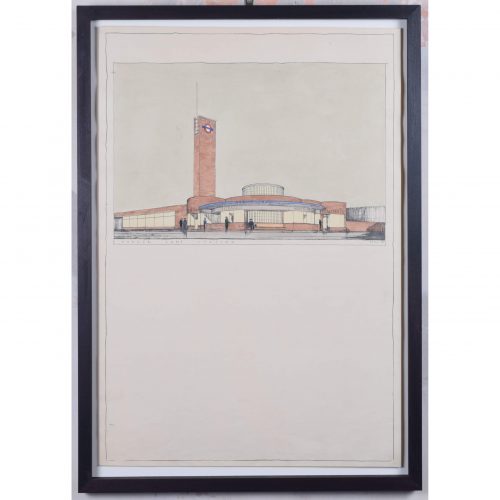-
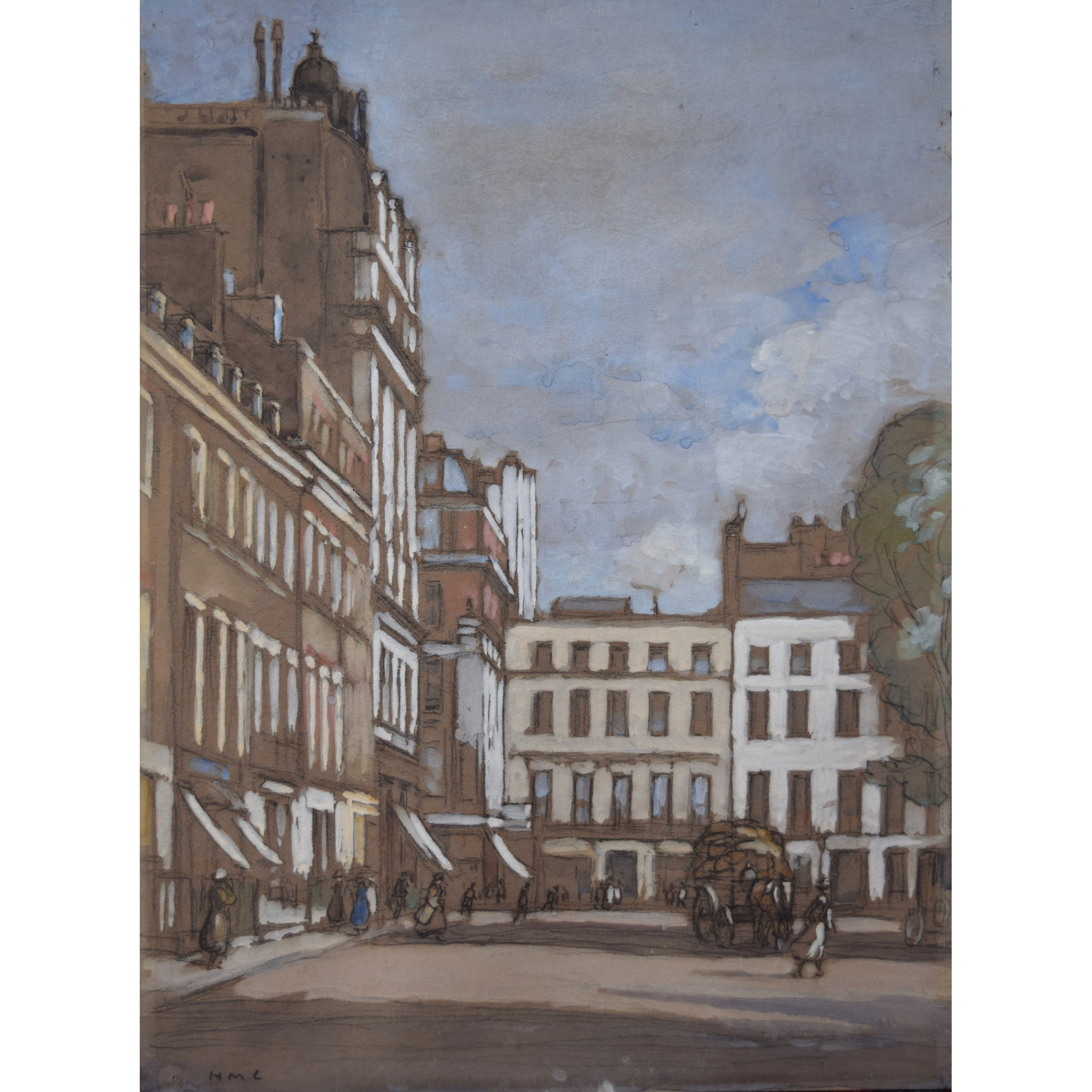
Horace Mann Livens (1862-1936)
Hanover Square London (1920)
Gouache on paper 37x27 cm For biographical details and other works by Livens click here. If you are interested email info@manningfineart.co.uk or call us on 07929 749056. -
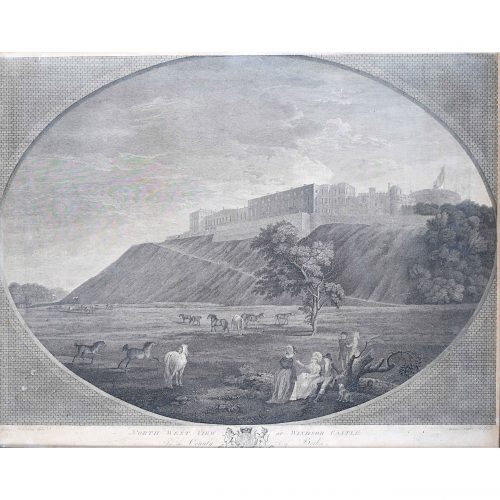
James Fittler (1758-1835) after George Robertson (1748-1788)
North West View of Windsor Castle in the County of Berks (1782)
47x58cm London: Published by John Boydell Fittler engraved two views of Windsor by Robertson. Trained at Royal Academy Schools, he was a skilled engraver and etcher and joined the mid-18th century trend for recording the landscape of the British Isles, producing and selling prints to tourists. A copy of this print is in the National Trust's collection at Anglesea Abbey, from Lord Fairhaven's extraordinary collection of views of Windsor Castle. -
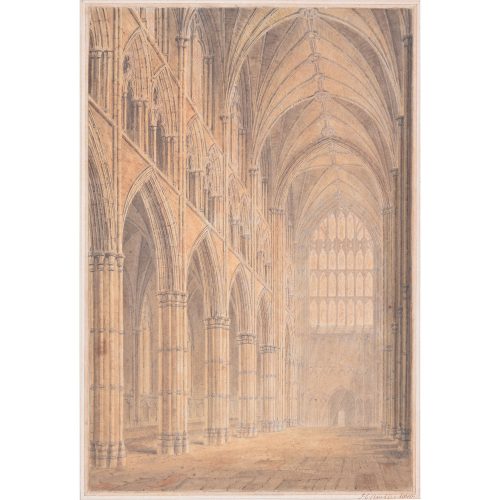
John Chessel Buckler (1793-1894)
The Nave of Westminster Abbey
Watercolour Signed, Titled and dated 1810 25x17 cm Click here for other works by Buckler and biographical detail. If you are interested email info@manningfineart.co.uk or call us on 07929 749056. -
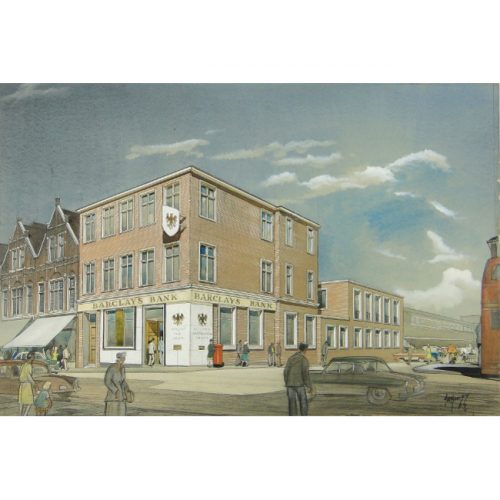
John Dean Monroe Harvey (1895-1978)
A design for Barclays Bank, Walthamstow (1964)
Signed and dated ‘J D M Harvey 64.’ Gouache on paper. A very fine architectural perspective by Harvey with his customary distinctive clouds and elegant people. The scheme was built, but the ground floor has since been rebuilt in a rather less satisfactory fashion. 41 x 60 cm (16 x 23 inches) For biographical details and more works by JDM Harvey, please click here. If you are interested email info@manningfineart.co.uk or call us on 07929 749056. -
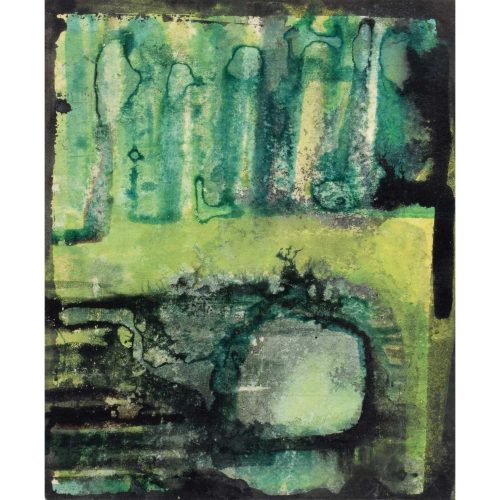
John Piper (1903-1992)
Study for the Piper Building mural
Gouache 14.5x11.5cm Provenance: P Manzareli (who built the fibreglass murals for Piper), gift from the artist; Milne & Moller Fine Art; Katharine House Gallery; private collection, Scotland. This study is a fascinating part of London's architectural history. The Piper Building is a mid-century architectural icon in Fulham. Built in the 1950s as 'Watson House', it was a laboratory complex for the North Thames Gas Board and has an innovative concrete structure. Piper was commissioned to produce the murals surrounding the building. The Gas Board moved out in the mid 1980s. Scheduled for demolition in the 1990s, the building was instead converted into seventy apartments and renamed the Piper Building. With double-height ceilings, the apartments were sold as shells, and purchasers were free to commission their own architects and builders. Condition: Generally excellent; framed. For other works by the artist and biographical details, click here. If you are interested email info@manningfineart.co.uk or call us on 07929 749056. -
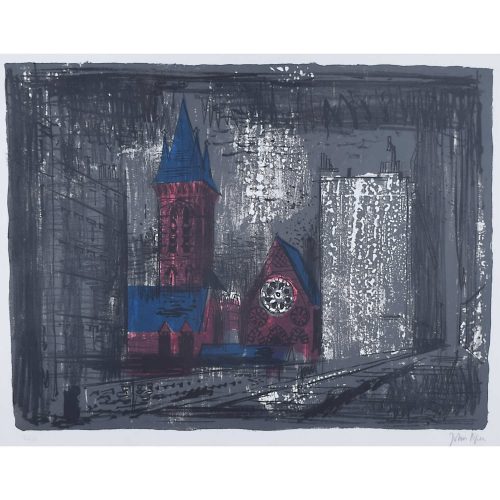
John Piper (1903-1992)
St James the Less, Westminster
Screenprint 65 x 49 cm From the 'Retrospect of Churches' series, numbered 24/70. Generally very good. Signed in pencil. John Piper CH was an English painter, printmaker, and designer of stained-glass windows. His work often focused on the British landscape, especially churches and monuments, and included tapestry designs, book jackets, screen-prints, photography, fabrics and ceramics. A Retrospect of Churches was issued as a suite of 24 original colour lithographs in colour, in an edition of 70 copies (70 numbered copies plus five artist's proofs). This poignant and dramatic representation of St James the Less is an evocative depiction of this part of London in the evening: wet pavements reflect the bright lights of the buildings, and the church is a warm, moody reddish-purple against the deep black of a dark night. Condition: Generally very good. -

Julian Trevelyan (1910-1988)
Father Thames (1969)
Etching and aquatint, signed, numbered 53/75 35x48cm Click here for biographical details and other works by the artist. If you are interested email info@manningfineart.co.uk or call us on 07929 749056. -
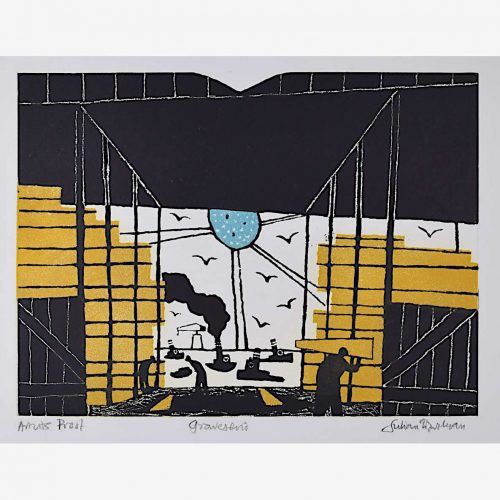
Julian Trevelyan (1910-1988)
Gravesend (1969)
Etching and aquatint, signed, titled, and inscribed 'Artist's Proof' in pencil 35x48cm (sheet size 59x77cm) On J Green paper Condition: generally excellent, never previously framed, see image. Click here for biographical details and other works by the artist. If you are interested email info@manningfineart.co.uk or call us on 07929 749056. -

Julian Trevelyan (1910-1988)
Kensington Gardens (1969)
Etching and aquatint, signed, numbered 55/75 35x48cm Click here for biographical details and other works by the artist. If you are interested email info@manningfineart.co.uk or call us on 07929 749056. -

Julian Trevelyan (1910-1988)
Richmond (1969)
Etching and aquatint, signed, numbered 47/75 48x35cm Click here for biographical details and other works by the artist. If you are interested email info@manningfineart.co.uk or call us on 07929 749056. -
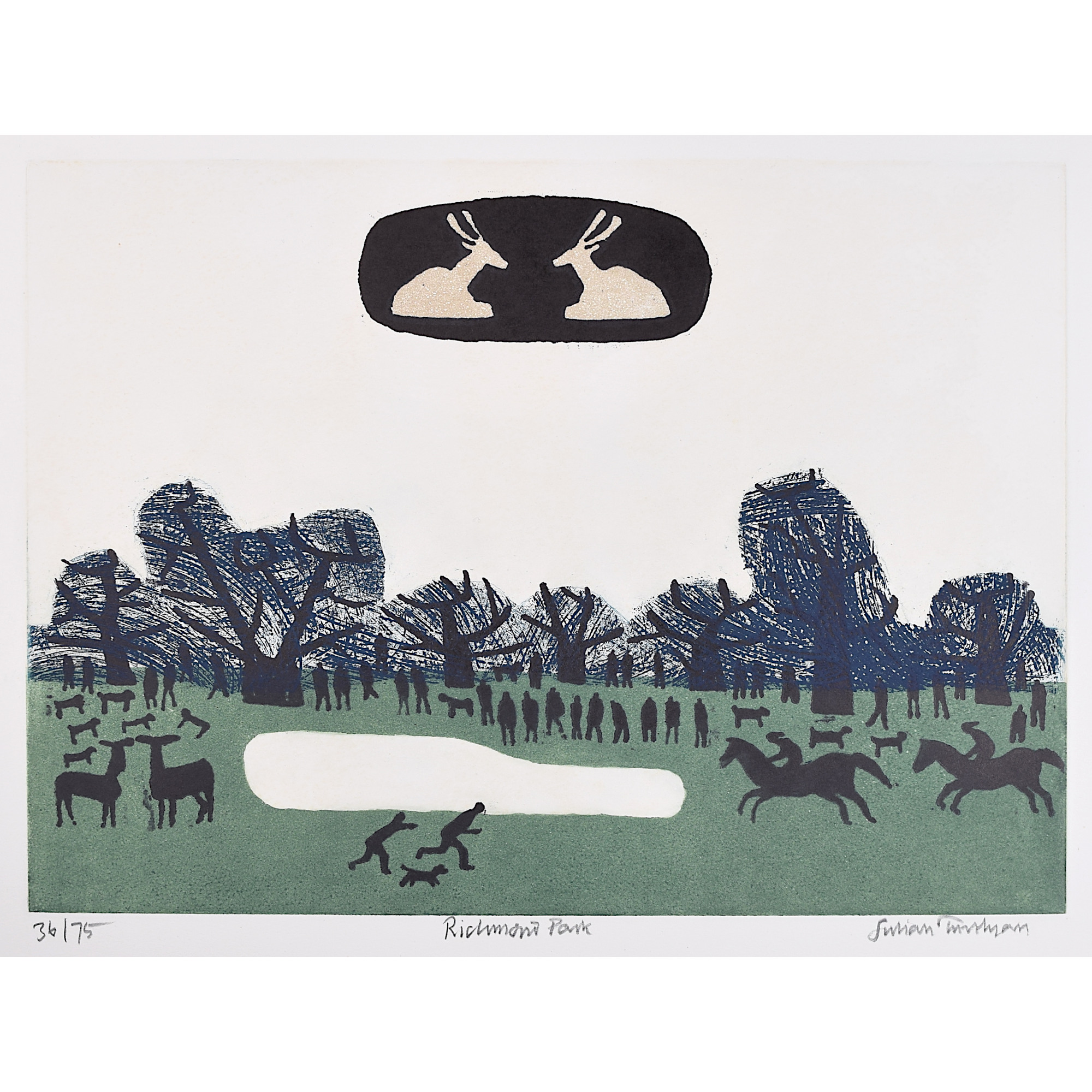
Julian Trevelyan (1910-1988)
Richmond Park (1969)
Etching and aquatint, Signed, numbered 36/75 35x48cm (sheet size 59x77cm) On J Green paper from the Thames Suite Click here for biographical details and other works by the artist including several others from the Thames Suite. If you are interested email info@manningfineart.co.uk or call us on 07929 749056. -

Julian Trevelyan (1910-1988)
St James' Park (1969-70)
Etching and aquatint, signed, numbered 48/75 35x48cm Click here for biographical details and other works by the artist. If you are interested email info@manningfineart.co.uk or call us on 07929 749056. -
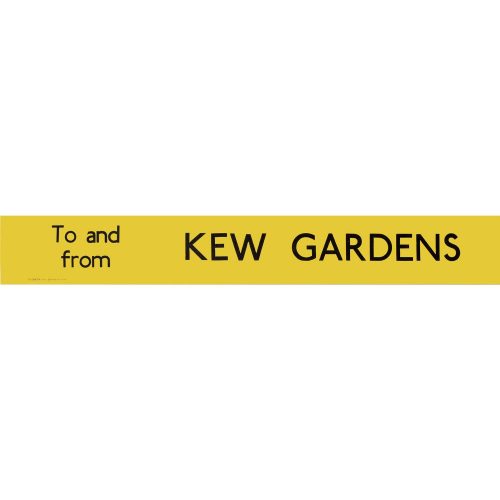
Anon.
Kew Gardens Routemaster
Slipboard Poster c.1970 Screenprint poster 64x9cm In a black hand-finished frame. Printed for London Transport for use on Routemaster or RT buses. If you are interested email info@manningfineart.co.uk or call us on 07929 749056. Condition: Excellent. -
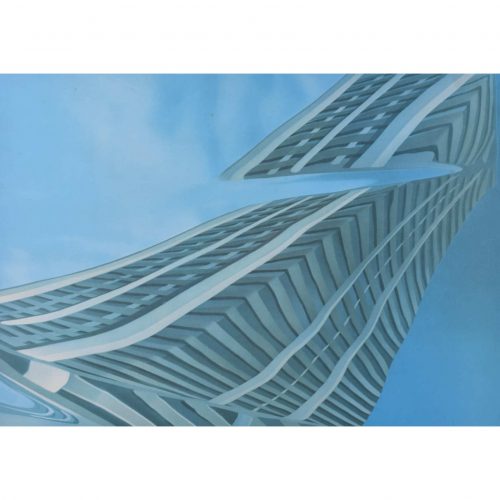
Brendan Neiland (b.1941) R.A. (Expelled)
Hyde Park Barracks, Knightsbridge (1979)
Screenprint 35 x 51 cm Signed, titled, dated and numbered 153/300 in pencil. A print of the facade of Hyde Park Barracks, reflected in still water and backed by a bright blue sky. Reflected architecture is one of Neiland's most recurring themes. The Hyde Park Barracks (often known as Knightsbridge Barracks) on the southern edge of Hyde Park. The barracks are 3⁄4 mile from Buckingham Palace, enabling the officers and soldiers of the Household Cavalry to be available to respond speedily to any emergency at the Palace, practice drills on the Horse Guards Parade, and conduct their ceremonial duties. Neiland is known for his interpretations of city life. His work is widely exhibited in major museums and galleries worldwide including, in Britain, the Victoria and Albert Museum, The Tate Gallery London, The Collections of the British Council and the Arts Council of Great Britain. He is represented by the Redfern Gallery and has had numerous shows internationally, including at the Galerie Belvedere in Singapore, who represent him in Singapore and the Far East. Condition: slight browning to sheet; small stain to top right corner. When mounted this will not be perceptible. If you’d like to know more, please email info@manningfineart.co.uk or call us on 07929 749056. -
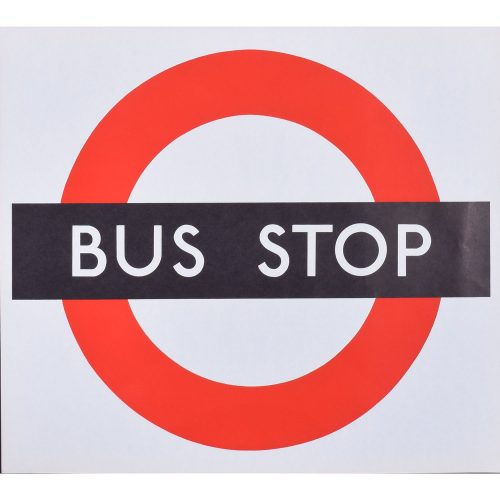
'Zero' Hans Schleger
London Transport Bus Stop Poster
Screenprint poster c. 1970s 16x14" Printed for London Transport Includes hand-finished black frame. If you are interested email info@manningfineart.co.uk or call us on 07929 749056. -
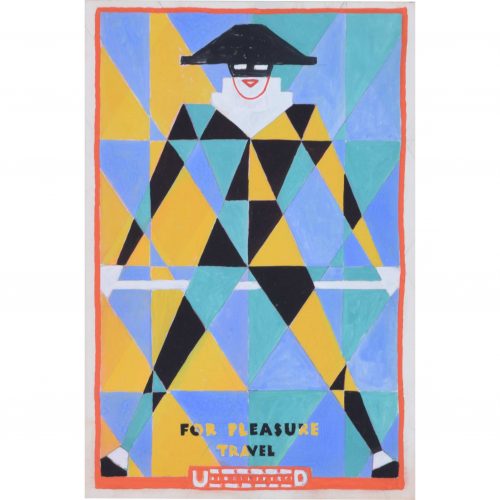
Gerald Mac Spink (flourished 1920 - 1940)
For Pleasure, Travel by Underground (c. 1930)
Gouache 26 x 18 cm Original design for a London Transport poster. Framed. A dynamic Art Deco poster design by Mac Spink. A boldly-coloured harlequin figure encourages travel via the London Underground. Spink was a skilled artist and designer who produced a series of posters in the inter-war period for companies including the London Underground, Southern Railways, LNER, Hawker Engineering, and British Steel. He won a prize in 1933 from the Imperial Institute for his poster artwork. He also worked as an aeronautical engineer in Kingston-on-Thames for Hawker Engineering; his greatest achievement was the creation of the 'Squanderbug', a 500cc racing car which he built in 1947, and which races even to this day. Provenance: the artist's estate. Condition: good; a few small scuffs to gouache, as visible in photographs. Handsomely framed. If you’d like to know more, please email info@manningfineart.co.uk or call us on 07929 749056. -
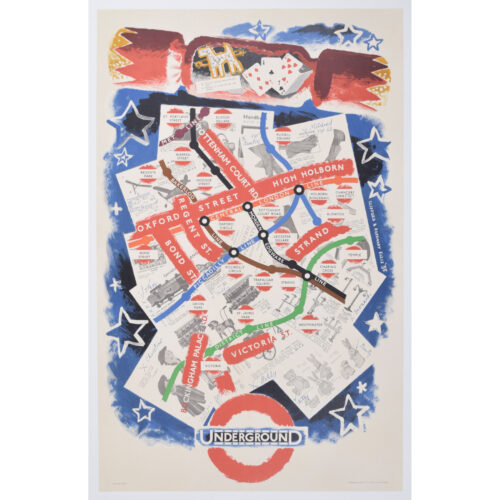
Clifford and Rosemary Ellis
London Underground Map (1935)
Original vintage poster 103 x 64 cm Signed in the plate 'Clifford & Rosemary Ellis '35". Printed by Waterlow & Sons Ltd for London Transport. Provenance: the artists' studio. This marvellous original vintage poster was designed for London Transport and encourages shoppers to use the Tube to do their Christmas shopping. The map of London's streets of shops, including Oxford Street, Regent Street, and Bond Street, are set on the background of a Christmas shopping list and various items to be purchased. The cross-section of a Christmas cracker at the top of the poster includes the joke: 'Why is a railway timetable like life?' - 'Because it is full of ups and downs. London Transport was the forerunner of London Underground. During the 1930s London Transport commissioned over forty posters a year from well-known artists such as Laura Knight, CRW Nevinson, Edward Wadsworth, Eric Ravilious, Paul Nash, Graham Sutherland, and Edward McKnight Kauffer – a bold policy that did much to popularise avant-garde artistic styles that stemmed from Cubism, Futurism and Abstraction. Condition: very good; backed to linen. If you are interested, please email info@manningfineart.co.uk or call us on 07929 749056. Click here for other original vintage London Transport posters. -
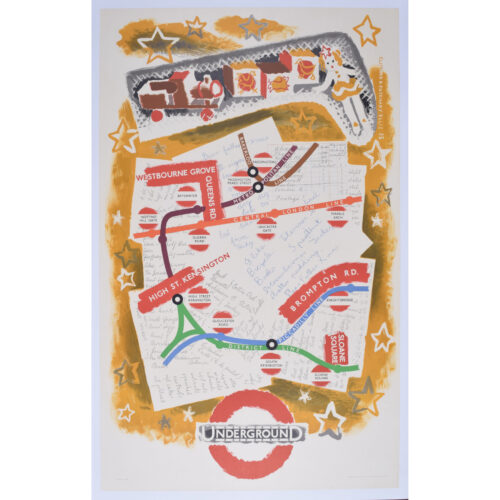
Clifford and Rosemary Ellis
London Underground Map (1935)
Original vintage poster 103 x 64 cm Signed in the plate 'Clifford & Rosemary Ellis '35". Printed by Waterlow & Sons Ltd for London Transport. Provenance: the artists' studio. This marvellous original vintage poster was designed for London Transport and encourages shoppers to use the Tube to do their Christmas shopping. The map of London's streets of shops, including High Street Kensington, Westbourne Grove, and the Brompton Road, are set on the background of Christmas wishlists and shopping lists. The cross-section of a Christmas stocking at the top of the poster includes a doll and a toy train amongst other stocking fillers. London Transport was the forerunner of London Underground. During the 1930s London Transport commissioned over forty posters a year from well-known artists such as Laura Knight, CRW Nevinson, Edward Wadsworth, Eric Ravilious, Paul Nash, Graham Sutherland, and Edward McKnight Kauffer – a bold policy that did much to popularise avant-garde artistic styles that stemmed from Cubism, Futurism and Abstraction. Condition: very good; backed to linen. If you are interested, please email info@manningfineart.co.uk or call us on 07929 749056. Click here for other original vintage London Transport posters. -
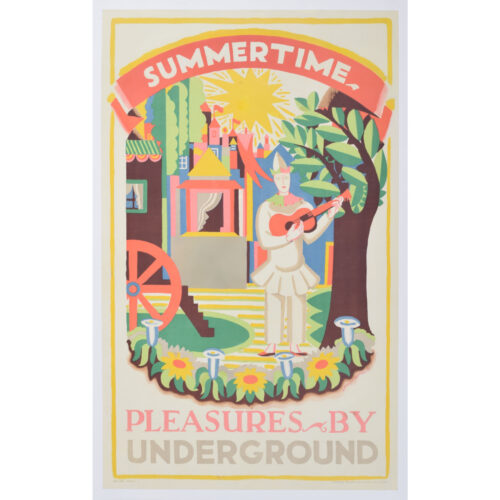
Edward McKnight Kauffer (1890 - 1954)
Summertime - Pleasures by Underground (1925)
Original vintage poster 101 x 63 cm Signed and dated in plate. Issued by the Underground Electric Railways Co. of London, Ltd., 1925. This is one of a series of posters designed by Edward McKnight Kauffer bearing the legend 'Summertime - Pleasures by Underground'. A doleful Pierrot figure (a lovestruck clown character from commedia dell'arte) plays a lute before a castle with streaming pennants; a country caravan, daffodils, leafy trees and a bright yellow sun complete the scene. Other posters from the series include similar traditional folk characters, such as a Jack-in-the-green. Edward McKnight Kauffer was an American artist and graphic designer who lived for much of his life in the United Kingdom. He is mainly known for his work in poster design, but was also active as a painter, book illustrator and theatre designer. He studied art at the California School of Design from 1910 to 1912 and then at the Académie Moderne in Paris until 1914 (via a six month stint at the Art Institute of Chicago). He moved to London upon the start of the First World War and produced 140 poster for London Underground and London Transport. He created posters for Shell Oil, the Great Western Railway and other commercial clients, and also illustrated books and book covers. Later he also became interested in textiles, interior design, and theatrical design. He returned to New York City in 1940 and began designing posters for American Airlines (his primary client until his death) in 1947 .In 1952 he designed the book jacket for Ralph Ellison's novel Invisible Man - arguably Kauffer's most famous work. Condition: generally very good; backed to linen. If you are interested, please email info@manningfineart.co.uk or call us on 07929 749056. Click here for other original vintage London Transport posters. -
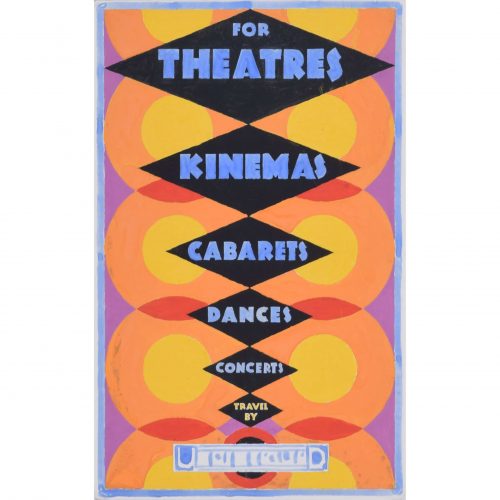
Gerald Mac Spink (flourished 1920 - 1940)
For Theatres, Kinemas, Cabarets, Dances, Concerts, Travel by Underground (c. 1930)
Gouache 30 x 19 cm Original design for a London Transport poster. Framed. A fantastic gouache design by Spink for a London Underground poster. The artist's striking Art Deco design and heady use of colour advertises the glamour of travelling by Tube to various evening entertainments around London. Spink was a skilled artist and designer who produced a series of posters in the inter-war period for companies including the London Underground, Southern Railways, LNER, Hawker Engineering, and British Steel. He won a prize in 1933 from the Imperial Institute for his poster artwork. He also worked as an aeronautical engineer in Kingston-on-Thames for Hawker Engineering; his greatest achievement was the creation of the 'Squanderbug', a 500cc racing car which he built in 1947, and which races even to this day. Provenance: the artist's estate. Condition: good; a few small scuffs to gouache, as visible in photographs. Handsomely framed. If you’d like to know more, please email info@manningfineart.co.uk or call us on 07929 749056. -
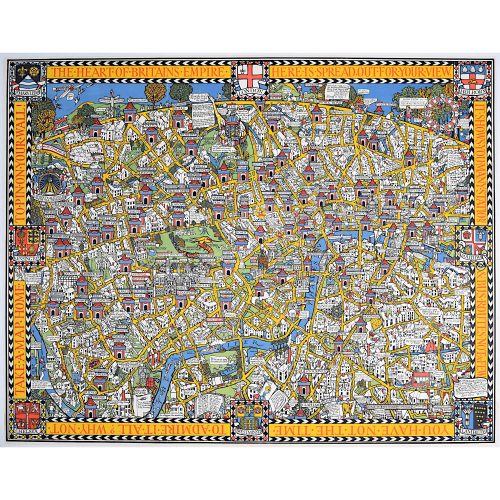
Macdonald (Max) Gill (1884-1947) Wonderground Map of London (c. 1924, after 1914 original edition)
Lithographic poster 75x94cm In the present work, in the top left-hand corner it reads 'On to Wembley' making reference to the British Empire Exhibition of 1924. Gill's original 1914 poster was hugely popular and reprinted with updates to feature topical events. Born in Brighton, Max Gill was the second son in a family of thirteen children; his elder brother was Eric Gill, the typographer and sculptor. Both Gills exhibited significant talent at a young age. Max Gill’s first map was made for a school map-drawing project following which he entered maps into competitions in boys’ magazines. In 1903 he moved to London as assistant to the ecclesiastical architects Sir Charles Nicholson and Hubert Corlette. By 1908 he had started his own architectural practice, but in 1909 Sir Edwin Lutyens commissioned Gill to paint a “wind dial” map for Nashdom, a large house in Buckinghamshire. The wind dial was set over the fireplace and attached to a weather vane on the roof, allowing the occupant to know the direction of the wind from the comfort of the house. He produced seven further wind dials including for Lutyens’s Lindisfarne Castle and for the Allhusen Room at Trinity College, Cambridge. Although he continued to practice as an architect, Frank Pick commissioned him to create seven pictorial maps for the Underground, the first being the famous 1913 ‘Wonderground Map of London Town.’ In 1917 he joined the Imperial War Graves Commission’s headstone design committee, designing the typeface and regimental badges. Gill’s memorials for the fallen in the First World War include for Balliol and Worcester Colleges and Christ Church in Oxford. During the 1920s and 30s Gill undertook many commercial commissions for advertising materials. The Empire Marketing Board and Shell-Mex as well as further maps for the Underground. He designed in 1922 the first diagrammatic map of the Underground which provided the foundation for Beck’s more famous map. By the 1930s his major works were murals. Those of the Arctic and Antarctic on the ceilings of the Scott Polar Research Institute in Cambridge are beautiful, but the most impressive is the map of the North Atlantic in the first-class dining room of the Queen Mary (maiden voyage: 1936, now moored at Long Beach, California). During the Second World War he created a series of propaganda posters for the Ministry of Information. -
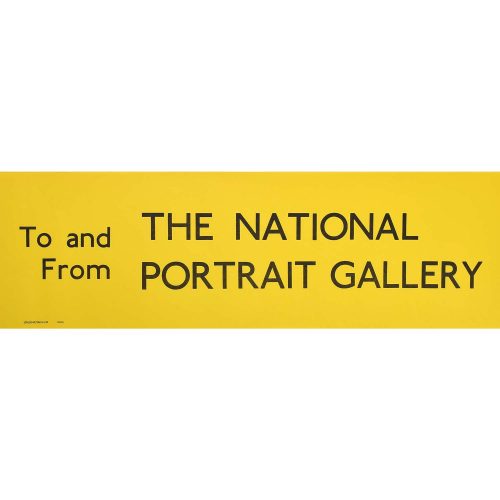
National Portrait Gallery Routemaster Slipboard Poster c1970
Screenprint poster 64x19cm Printed for London Transport for use on Routemaster or RT busses. If you are interested email info@manningfineart.co.uk or call us on 07929 749056. Condition: Excellent -
Out of stock
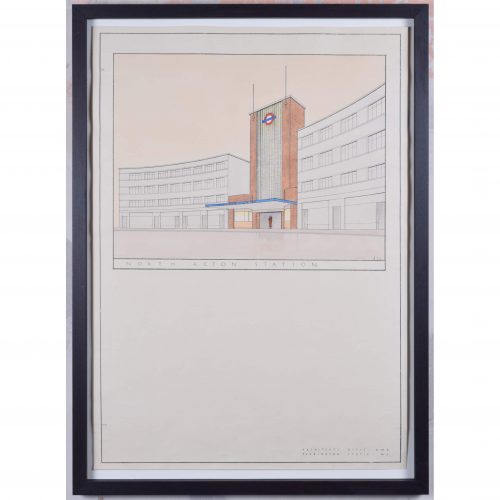
Brian Bannatyne Lewis (1906 - 1991)
North Acton Station (1938)
Pen, ink and watercolour 70 x 50 cm Initialled and dated 26 2 38. A 1938 design for the new North Acton tube station, commissioned by the Great Western Railway (GWR) for its proposed western extension to the Central Line. The design's Art Deco lettering befits London Transport's aesthetic in the 1930s. Lewis brings his designs to life by including smartly-dressed characters entering and leaving the stations. The Central line opened in 1900, between Shepherd's Bush and Bank; it extended westwards to Ealing Broadway in 1920. Two years after the formation of London Transport in 1933, an extensive New Works Programme began, proposing a westwards extension of the line to Denham. Brian Lewis created designs for nine stations in early 1938, but the Second World War broke out before they could be built. By the time the extension had been built, Lewis was no longer chief architect of the GWR - the stations were modified and completed by Frederick Francis Charles Curtis instead. The extension to Greenford opened in 1947 and finally reached West Ruislip in 1948. Denham never actually became part of the tube line, owing to the establishment of the green belt. Brian Lewis was born in Tasmania, attended school in Melbourne, and subsequently obtained a Diploma in Architecture in 1928 from the University of Melbourne. He then moved to the UK to study at the Liverpool School of Architecture, winning scholarships in each of his three years of study to fund extensive European travel. He married a fellow Liverpool architectural student, Hilary Archer. After moving to London, he took up employment with the GWR in their architects’ office; he also lectured at a local polytechnic, and moonlighted with his wife at home on mainly residential commissions – rather different projects from the hotels and stations which GWR commissioned from him. He exhibited frequently at the Royal Academy of Arts, showing superb measured drawings of historic buildings. In the Second World War he enlisted with the Second Imperial Australian Force, serving in the Middle East, then transferred to the Royal Australian Engineers where he became a Captain. In 1943 he was sent to London to help GWR repair bomb damage. Lewis became Chief Architect of GWR in 1945 (following the retirement of the noted Percy Emerson Culverhouse), and the first Chair of Architecture at Melbourne University in 1947. He also became the consulting architect for the major buildings of the Australian National University in Canberra, producing an imaginative site plan and designing University House, which was awarded the Sulman medal in 1954. He also designed the Risdon Prison Complex in 1960. He retired in 1971 to paint watercolours and write his memoirs. Condition: generally very good; a few handling marks and two holes from filing. Handsomely framed. If you are interested, please email info@manningfineart.co.uk or call us on 07929 749056. Click here to view the other station designs in the set. -
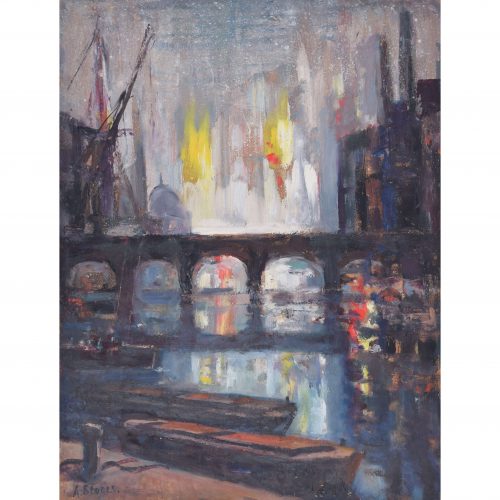
Angela Stones (1914 - 1995)
Old London Bridge Fantasia (1968)
Oil on board 56 x 43 cm Signed lower left. A fantasia inspired by Old London Bridge on the Thames. The grey dome of St Paul's peeps over the bridge; bright lights burn in the background, throwing yellows and red reflections onto the water. Moored boats bob gently in the foreground. Stones was educated at the Chelsea School of Art, and was a member of an artistic dynasty. Her mother Dorothy Bradshaw (1893-1983) studied under Jack Merriott – the artist famous for his British Rail posters, and her son, Christopher Assheton-Stones (1947-1999), was arguably the foremost pastel artist of his time. Provenance: the family of the artist. Condition: very good. If you’d like to know more, please email info@manningfineart.co.uk or call us on 07929 749056. -
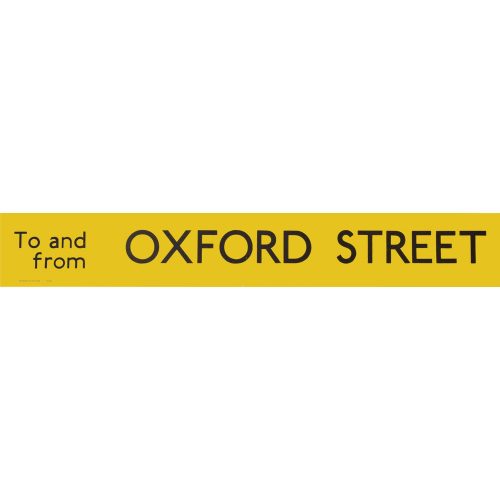
Anon.
Oxford Street Routemaster
Slipboard Poster c.1970 Screenprint poster 64x9cm In a black hand-finished frame. Printed for London Transport for use on Routemaster or RT buses. If you are interested email info@manningfineart.co.uk or call us on 07929 749056. Condition: Excellent. -
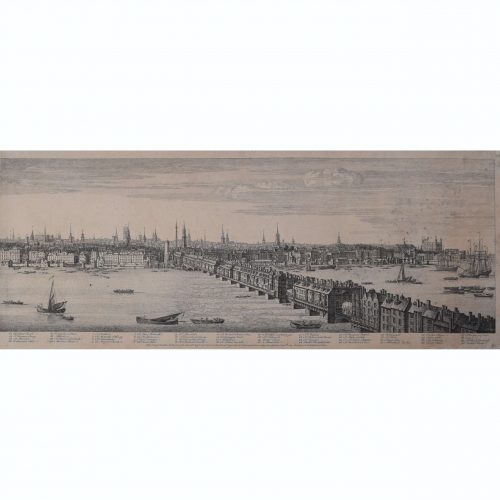
Samuel Buck (1696-1779) & Nathaniel Buck (active 1724-59) Panorama of the River Thames from Westminster Bridge to London Bridge
Published September 1749 30x404 cm Engraving Scroll down for further description. If you are interested email info@manningfineart.co.uk or call us on 07929 749056. -
Out of stock
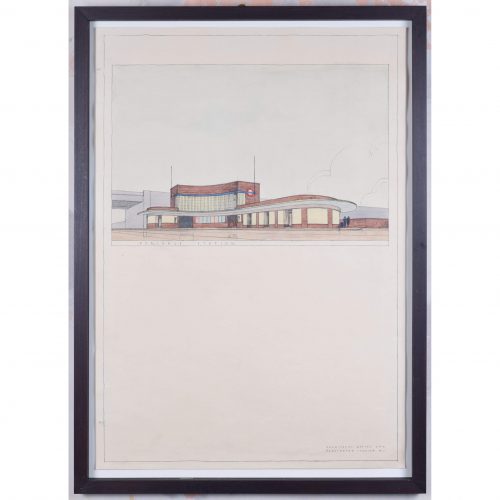
Brian Bannatyne Lewis (1906 - 1991)
Perivale Station (1938)
Pen, ink and watercolour 70 x 50 cm A 1938 design for the new Perivale tube station, commissioned by the Great Western Railway (GWR) for its proposed western extension to the Central Line. The design's Art Deco lettering befits London Transport's aesthetic in the 1930s. Lewis brings his designs to life by including smartly-dressed characters entering and leaving the stations. The Central line opened in 1900, between Shepherd's Bush and Bank; it extended westwards to Ealing Broadway in 1920. Two years after the formation of London Transport in 1933, an extensive New Works Programme began, proposing a westwards extension of the line to Denham. Brian Lewis created designs for nine stations in early 1938, but the Second World War broke out before they could be built. By the time the extension had been built, Lewis was no longer chief architect of the GWR - the stations were modified and completed by Frederick Francis Charles Curtis instead. The extension to Greenford opened in 1947 and finally reached West Ruislip in 1948. Denham never actually became part of the tube line, owing to the establishment of the green belt. Brian Lewis was born in Tasmania, attended school in Melbourne, and subsequently obtained a Diploma in Architecture in 1928 from the University of Melbourne. He then moved to the UK to study at the Liverpool School of Architecture, winning scholarships in each of his three years of study to fund extensive European travel. He married a fellow Liverpool architectural student, Hilary Archer. After moving to London, he took up employment with the GWR in their architects’ office; he also lectured at a local polytechnic, and moonlighted with his wife at home on mainly residential commissions – rather different projects from the hotels and stations which GWR commissioned from him. He exhibited frequently at the Royal Academy of Arts, showing superb measured drawings of historic buildings. In the Second World War he enlisted with the Second Imperial Australian Force, serving in the Middle East, then transferred to the Royal Australian Engineers where he became a Captain. In 1943 he was sent to London to help GWR repair bomb damage. Lewis became Chief Architect of GWR in 1945 (following the retirement of the noted Percy Emerson Culverhouse), and the first Chair of Architecture at Melbourne University in 1947. He also became the consulting architect for the major buildings of the Australian National University in Canberra, producing an imaginative site plan and designing University House, which was awarded the Sulman medal in 1954. He also designed the Risdon Prison Complex in 1960. He retired in 1971 to paint watercolours and write his memoirs. Condition: generally very good; a few handling marks and two holes from filing. Handsomely framed. If you are interested, please email info@manningfineart.co.uk or call us on 07929 749056. Click here to view the other station designs in the set. -
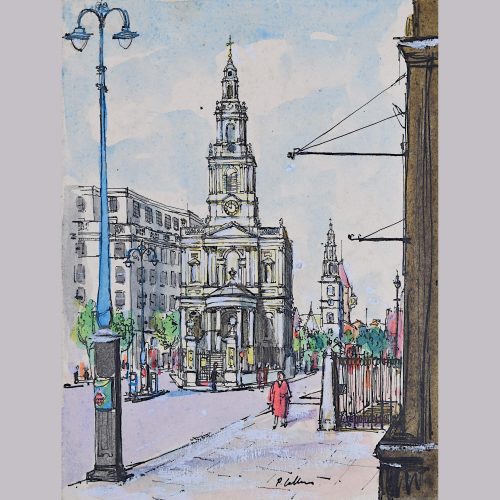
Peter Collins ARCA (1923-2001) St Mary le Strand Church
Watercolour 17 x 21 cm Signed lower right. Provenance: The artist's studio. Typical Collins, with his bright colours and captivating scene, reminiscent of his travel posters, here a passerby in red walks purposely towards the foreground. Click here for other items by the artist and for biographical details. If you are interested email info@manningfineart.co.uk or call us on 07929 749056. -
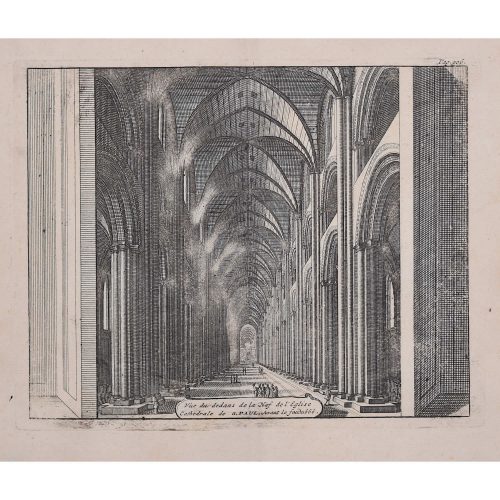
Pieter van der Aa (1659-1733), after Jan Kip (1652/3-1722)
Old St Paul's Cathedral (1707)
Engraving, 14 x 17 cm A view of the nave of Old St Paul's Cathedral, engraved by Pieter van der Aa after Johannes 'Jan' Kip, the Dutch draftsman, engraver and print dealer. Pieter van der Aa of Leiden was a Dutch publisher best known for preparing maps and atlases, though he also printed editions of foreign bestsellers and illustrated volumes. He is noted for the many engravings he produced after David Loggan's series of Oxford and Cambridge colleges and costumes. In 1727 Van Der Aa illustrated "Les Delices de la Grande Bretagne & de L'Irelande" by James Beeverell, the book in which this engraving appears. Condition: Generally very good. -
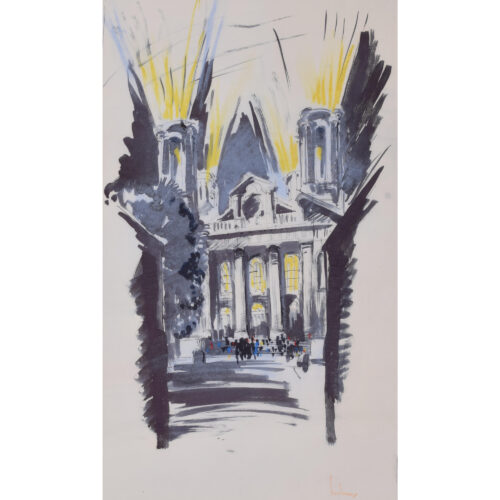
Louis Osman FRIBA (1914 - 1996)
Proposal for St John's Smith Square (1953)
Watercolour 62 x 37 cm Signed in red crayon lower right. Louis Osman's proposal for the post-war, post-bombing redevelopment of St John's church on Smith Square. Osman had envisioned an interior with a ceiling painted by Picasso; sadly, this project was never executed. The church was bombed in 1941 and gutted by fire; subsequently, the church was a ruin open to the sky for over 20 years. It was saved by Lady Parker of Waddington, who formed the Friends of St John's in 1962 to raise money and restore the church to its former glory - a reconstruction in the style of the church's original architect, Thomas Archer. Osman was as much an artist as an architect. This is likely a portfolio piece from his time studying at the Bartlett School of Architecture, and is as such a piece of architectural history as well as a beautiful Osman design. Osman was awarded a First Class degree and the Donaldson Medal of the RIBA (for the best result in his year group) by the Bartlett, and then went on to the Slade School of Art. He subsequently trained with Sir Albert Richardson - we also have several Richardson works in our collection. After the war, Osman busied himself as an architect. His work included contributions to Westminster Abbey, and Lincoln, Exeter, Ely, and Lichfield Cathedrals, Staunton Harold Church in Ashby de la Zouch for the National Trust, and of course his folly: the Grade I listed Elizabethan manor house, Canons Ashby in Northamptonshire, now a National Trust property. At Canons Ashby he established a workshop and had a team of silversmiths and goldsmiths working for him. In 1976 he made the gold enamelled coffin that holds the copy of the Magna Carta on view in the United States Capitol, Washington, DC. Condition: generally very good. If you’d like to know more, please email info@manningfineart.co.uk or call us on 07929 749056. -
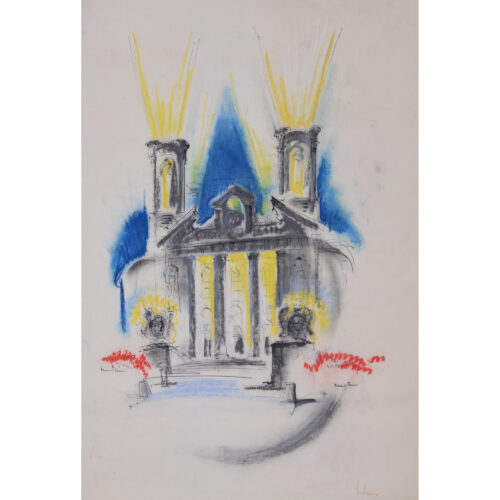
Louis Osman FRIBA (1914 - 1996)
Proposal for St John's Smith Square (1953)
Watercolour 70 x 52 cm Signed in red crayon lower right. Louis Osman's proposal for the post-war, post-bombing redevelopment of St John's church on Smith Square. Osman had envisioned an interior with a ceiling painted by Picasso; sadly, this project was never executed. The church was bombed in 1941 and gutted by fire; subsequently, the church was a ruin open to the sky for over 20 years. It was saved by Lady Parker of Waddington, who formed the Friends of St John's in 1962 to raise money and restore the church to its former glory - a reconstruction in the style of the church's original architect, Thomas Archer. Osman was as much an artist as an architect. This is likely a portfolio piece from his time studying at the Bartlett School of Architecture, and is as such a piece of architectural history as well as a beautiful Osman design. Osman was awarded a First Class degree and the Donaldson Medal of the RIBA (for the best result in his year group) by the Bartlett, and then went on to the Slade School of Art. He subsequently trained with Sir Albert Richardson - we also have several Richardson works in our collection. After the war, Osman busied himself as an architect. His work included contributions to Westminster Abbey, and Lincoln, Exeter, Ely, and Lichfield Cathedrals, Staunton Harold Church in Ashby de la Zouch for the National Trust, and of course his folly: the Grade I listed Elizabethan manor house, Canons Ashby in Northamptonshire, now a National Trust property. At Canons Ashby he established a workshop and had a team of silversmiths and goldsmiths working for him. In 1976 he made the gold enamelled coffin that holds the copy of the Magna Carta on view in the United States Capitol, Washington, DC. Condition: generally very good. If you’d like to know more, please email info@manningfineart.co.uk or call us on 07929 749056. -
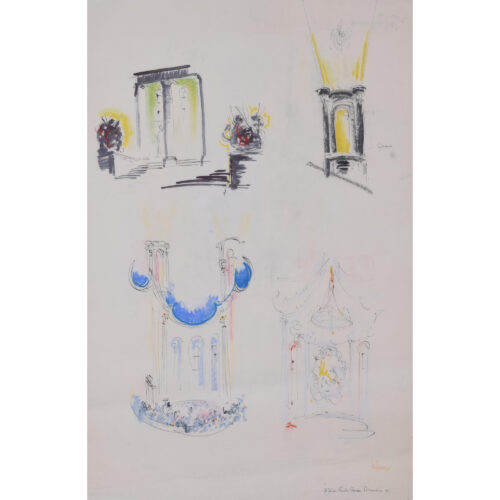
Louis Osman FRIBA (1914 - 1996)
Proposal details for St John's Smith Square (1953)
Watercolour 74 x 46 cm Signed in red crayon lower right. Details from Louis Osman's proposal for the post-war, post-bombing redevelopment of St John's church on Smith Square. Osman had envisioned an interior with a ceiling painted by Picasso; sadly, this project was never executed. The church was bombed in 1941 and gutted by fire; subsequently, the church was a ruin open to the sky for over 20 years. It was saved by Lady Parker of Waddington, who formed the Friends of St John's in 1962 to raise money and restore the church to its former glory - a reconstruction in the style of the church's original architect, Thomas Archer. Osman was as much an artist as an architect. This is likely a portfolio piece from his time studying at the Bartlett School of Architecture, and is as such a piece of architectural history as well as a beautiful Osman design. Osman was awarded a First Class degree and the Donaldson Medal of the RIBA (for the best result in his year group) by the Bartlett, and then went on to the Slade School of Art. He subsequently trained with Sir Albert Richardson - we also have several Richardson works in our collection. After the war, Osman busied himself as an architect. His work included contributions to Westminster Abbey, and Lincoln, Exeter, Ely, and Lichfield Cathedrals, Staunton Harold Church in Ashby de la Zouch for the National Trust, and of course his folly: the Grade I listed Elizabethan manor house, Canons Ashby in Northamptonshire, now a National Trust property. At Canons Ashby he established a workshop and had a team of silversmiths and goldsmiths working for him. In 1976 he made the gold enamelled coffin that holds the copy of the Magna Carta on view in the United States Capitol, Washington, DC. Condition: generally very good. If you’d like to know more, please email info@manningfineart.co.uk or call us on 07929 749056. -
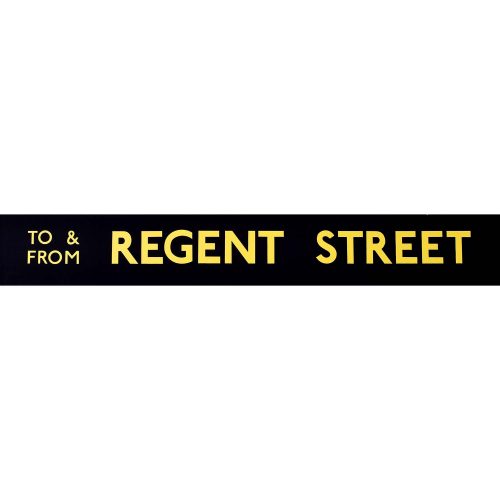
Anon.
Regent Street Routemaster
Slipboard Poster c.1970 Screenprint poster 64x9cm In a black hand-finished frame. Printed for London Transport for use on Routemaster or RT buses. If you are interested email info@manningfineart.co.uk or call us on 07929 749056. Condition: Excellent. -
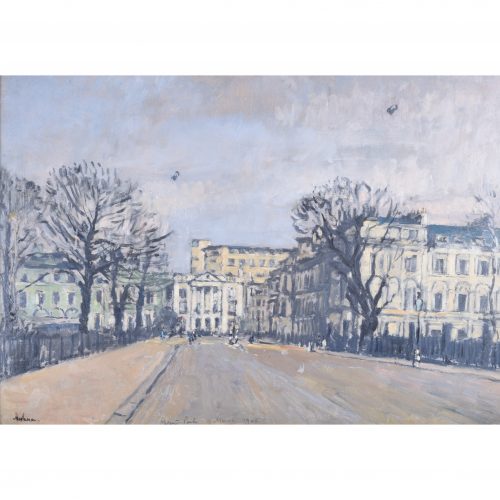
Paul Ayshford Methuen (1886 - 1974)
Barrage Balloons, Regents Park, 9 March 1940
Oil on board 36 x 52 cm Signed lower left and titled and dated lower centre. Lord Methuen's oil painting of Regent's Park on a winter's day, with barrage balloons above. Barrage balloons were set up - stationed at an altitude of around 4,000 ft - as a barrier to enemy aircraft. The steel cables used to tether the balloons would take an enemy aeroplane out of the sky if it were to hit the cable. The UK had thousands of them, filled partly with hydrogen and operated largely by women, to protect significant towns, cities, and military installations. These strange blobs floated over the country, just asking to be captured by artists. Methuen had rejoined his regiment (serving as a Captain) in 1939 but was likely stationed in London for a while, when he might have had the opportunity to capture this scene. When Methuen painted the scene in 1940, Britain was still in the stage of the phoney war. The Battle of Britain did not commence until 10 July, and the Blitz not until 7 September - but Britain's defences were ready. Barrage balloons were important all the way through the War: they defended London against the V2 missiles; they defended the D-Day invasion fleet; and they protected the invasion army for months. Indeed, it was said that the vast amount of material brought into the UK from the States prior to D-Day would have caused Britain to sink under the sea, were it not for the huge number of barrage balloons holding the country up... Condition: excellent. Recently revarnished. If you’d like to know more, please email info@manningfineart.co.uk or call us on 07929 749056. -

Richard Beer (1928-2017) Christ Church Newgate (1970)
Colour etching and aquatint on Velin Arches, published by Editions Alecto 63x48cm Full sheet size 73 x 55cm Signed, titled and numbered 75/150 Click here for biography and other works by this artist. If you are interested email info@manningfineart.co.uk or call us on 07929 749056. Condition: Print in good condition, margins well outside platemark show some discolouration and handling marks which will be hidden behind mat/mount. -
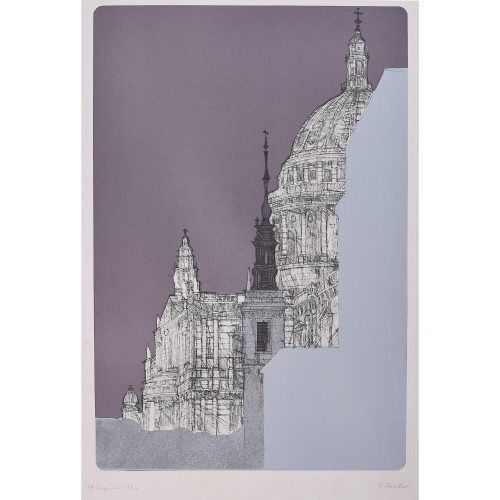
Richard Beer (1928-2017)
St Augustine's Church Watling Street London
Coloured etching and screen print Signed and numbered 57/75 to lower margin Plate size 63 x 43cm From 'Ten Wren Churches' St Augustine's Watling Street was first recorded in the 12th century, destroyed by the Great Fire of London in 1666 and then rebuilt as part of Christopher Wren's rebuilding of London. During the Second World War it was again destroyed, and the tower - restored in 1954 - is now a part of St Paul's Cathedral Choir School. Condition: slight toning to sheet and some discolouration to margins. A copy of this print is in the Government Art Collection. Click here for biography and other works by this artist. If you are interested email info@manningfineart.co.uk or call us on 07929 749056. -
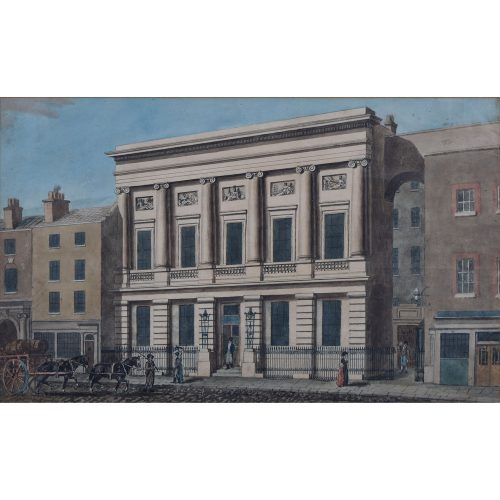
Schnebbelie (Robert Blemmell, circa 1785-1849) The Commercial Sale Rooms, Mincing Lane, City of London (c. 1814)
Pencil, pen, ink & watercolour 25 x 42 cm Captioned to mount, "Used as the Custom House after the Original House was Burnt from 1814 to 1817". With engraving of the same image pasted to reverse of frame, published by James Whittle & Richard H. Laurie, Jan. 16th, 1815. Schnebbelie was an English painter and illustrator who produced many views of London. His father, Jacob, was a confectioner who was subsequently employed by the Society of Antiquaries of London as a draughtsman, but who died at the age of 31. Following his death, Robert took up his father's profession. Between 1803 and 1821 he exhibited at the Royal Academy; Engravings based on his drawings were widely published - most notably in Robert Wilkinson's Londina Illustrata (1808-1825), David Hughson's Description of London and the Gentleman's Magazine. His works are in the collections inter alia of the Museum of London, the Guildhall Art Gallery and the Huntington Museum of Art in West Virginia. If you are interested email info@manningfineart.co.uk or call us on 07929 749056. -
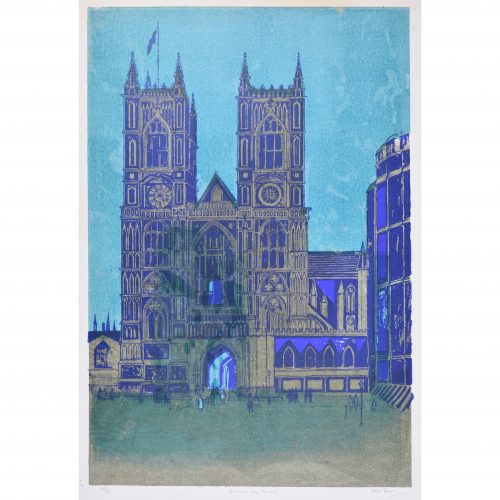
Robert Tavener (British) 1920 – 2004
Westminster Abbey (West Front) c.1970 Lithograph Signed in pencil ‘Robert Tavener’ and inscribed ‘Westminster Abbey (West Front)’ and numbered 45/50. £475 For other works by Robert Tavener and biographical details click here. If you are interested email info@manningfineart.co.uk or call us on 07929 749056. -
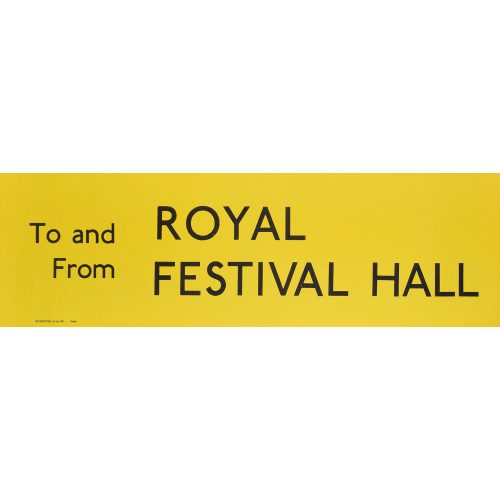
Royal Festival Hall Routemaster Slipboard Poster c1970
Screenprint poster 64x19cm In a black hand-finished frame. Printed for London Transport for use on Routemaster or RT busses. If you are interested email info@manningfineart.co.uk or call us on 07929 749056.

